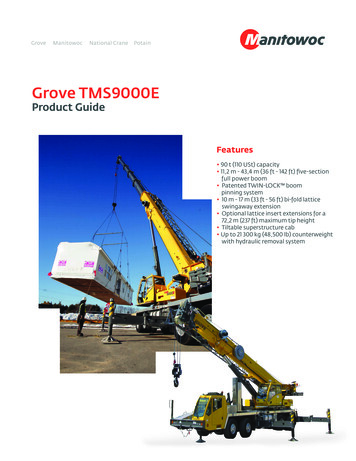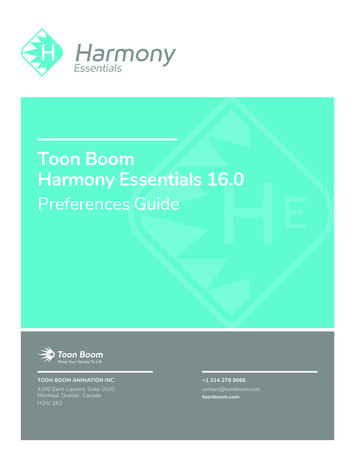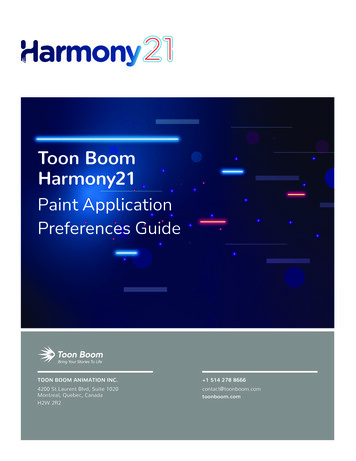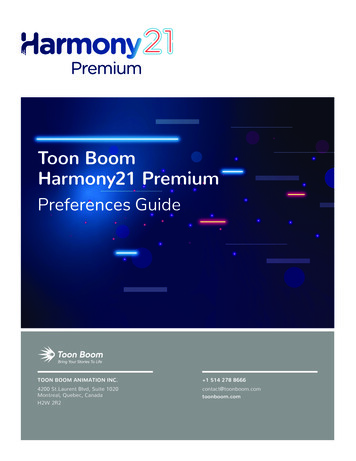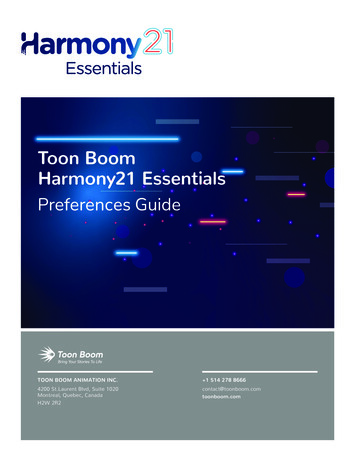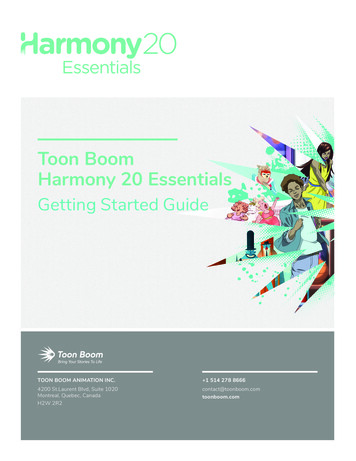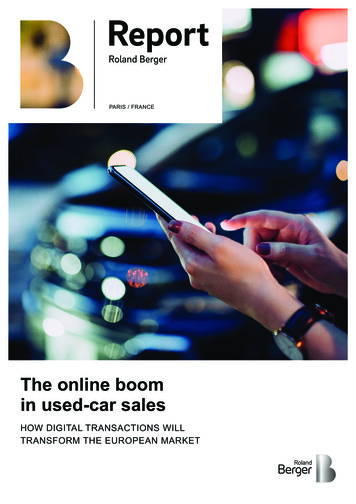
Transcription
PARIS / FRANCEThe online boomin used-car salesHOW DIGITAL TRANSACTIONS WILLTRANSFORM THE EUROPEAN MARKET
MANAGEMENTSUMMARY1. Build a strong and well-known brand2. Adopt a data-driven business3. Combine online and physical locations4. Set up advanced refurbishment centers5. Tightly control logistics flows6. Ensure vehicle sourcing is efficient and diversifiedA digitally oriented business model that successfully integrates thesekey success factors will ensure a competitive online business. Butfor all the players, these factors represent entry barriers that requiresignificant investment. A lot of players will not be able to make thedigital move, which will drive up market consolidation and profitability.Investors are convinced about the digital transformation of the usedcar market and are prepared to make huge funds available – more thanEUR 1 billion was raised over the past 12 months.Roland Berger2Used-car online salesCover photo Yiu Yu Hoi/Getty ImagesThe European used-car (UC) market was valued at EUR 410 billion in2020. It is forecast to grow at 3-4% per year in the coming years. TheB2C (retail) segment of the UC market represents 40% of volume but55% of value. Traditional dealers account for 99% of transactions, withonline retailers and new retailers (mostly leasers, C2B cash buyers andauction players) having a 1% share.The European retail trade is highly fragmented. Combined, the topfive players account for 6% of total European B2C market volume.This high fragmentation, and dealers’ limited investment capacity fordevelopments like digitalization, mean operations remain traditional.Fully digital customer journeys, however, offer a much better experience,alleviating pain points such as multiple point-of-sale visits. SomeEuropean used-car players are moving online, but many pain pointsremain, for example paperwork for financing and same-day payments.No player has yet built a strong trusted brand.We expect the European B2C used-car market to rapidly move toonline sales in the coming years, as has happened in the US, with theshare of online sales doubling to 10% by 2025.Carvana is a good example of a US success story. Its valuationhas risen almost 900% since its IPO in 2017, with a current value ofEUR 40 billion. To be successful, a digitally oriented business modelis required. This will differ significantly from the traditional businessmodel and should be built around six key success factors:
FAST FACTS& CONTENTS18 %p.a. online salesgrowth over 2020-251 bneuros raised for thedigitalization of used-carmarket in 20201/ INTRODUCTION42/ MARKET OVERVIEW: AN ATTRACTIVE SECTORWITH A FRAGMENTED COMPETITIVE LANDSCAPE52.1 A huge, growing and resilient market2.2 A fragmented competitive landscape3/ THE ONLINE BOOM: HOW DIGITAL SALESARE REVVING UC MARKET73.1 The perils of buying a used car the traditional way3.2 Online sales are set to boom acrossthe UC retail market4/ MOVING ONLINE: THE KEY FACTORS BEHINDA SUCCESSFUL DIGITAL TRANSFORMATION114.1 Developing a digitally oriented business model4.2 Funding the transformation5/ CONCLUSION14
A/Top specs Key figures for the European used-car market in 2020EUR 410 bn 3-4 % p.a.55 %EuropeanUC market valueLong-term growthtrend of the recent(2015-2025)UC marketShare of B2C inUC market value70 %36 millionShare of recentvehicles (less than8 years old) inUC market valueEuropeanUC market volumeSource: Roland Berger1/IntroductionThe European used-car market is thriving. While the coronavirus crisis hasundoubtedly affected sales, the long-term outlook is good. The market is currentlyworth EUR 410 billion and is expected to grow at 3-4% a year in the near term.Yet the industry has a problem. The process of buying a car remains relativelyantiquated, as retailers have limited funds to invest in digital sales channels orbusiness models. Most still rely on traditional methods, and this is holding theindustry back. Fully online transactions promise to help overcome severalexisting pain points in the customer journey, such as burdensome paperworkand visits to multiple points of sale. They also promise many additional benefits,not least instant access to a wide range of vehicles and easy price benchmarking.In this report we review the status of the existing European used-car market andits challenges, with a focus on retail, and look at the impact of digitalizationand, more specifically, online sales. We outline six key digital success factorsrelevant to all used-car players, ranging from developing a strong digital brandto creating data-driven business models. We also examine the effects of externalfunding.Roland Berger4Used-car online sales
2/Market overview: An attractive sectorwith a fragmented competitive landscape2.1 / A huge, growing and resilient marketUsed cars are big business. The European used-car (UC) market was worth anestimated EUR 410 billion in 2020, with a turnover of 36 million units. It hasbeen growing for many years and is forecast to continue doing so at 3-4% peryear until 2025 (excluding Covid-19 turbulence in 2020). Volume growth ismainly driven by the vehicle parc size (number of vehicles in use), which in turnis shaped by growing populations and rates of vehicle use per head. Parc inertiahelps to make the market resilient. In addition, volume benefits from the growingpenetration of leasing solutions, both private leasing and long-term rentals,which increase UC sales frequency. Average prices are also increasing, pushedhigher by the rise in new vehicle prices (the result, for example, of more salesof expensive SUVs, the higher prices of hybrid vehicles and tougher regulations)and the falling average age of used cars sold (leasing impact). AThe UC market can be split into two segments: B2C (retail) and C2C. B2Crepresents 40% of volume but 55% of value due to its dominance in sales ofrecent vehicles. The C2C segment represents 60% of volume but 45% of valueas it mainly involves sales of older vehicles.IMPACT OF ELECTRIC VEHICLES ON THE UC MARKETBoost B2C over C2C: Dealers stand to especially benefit from electric vehicles (EVs).First, most new EVs are leased due to consumer fears over residual values, meaningdealers are likely to secure the majority of used EV sales. Second, potential EV buyershave a greater need for reassurance, something professionals can do much better thanprivate sellers.Favor UC leasing: As with new EVs, used-EV buyers prefer to lease their vehicle for thesame reasons, that is, fear of losing residual value and a greater need for reassurance.Generate sales of new services: For example, charging unit hardware and installations,charging subscriptions, extended warranty contracts on batteries, etc.Increased pressure on used-vehicle profitability: Traditional dealers were able toafford limited profits on ICE used-vehicle sales because of high aftersales profits. Butthis equation does not work with EVs because of their lower aftersales needs. As aresult, dealers will have to make the sale of used vehicles more profitable.Increased competition for battery and high-voltage network maintenance: Newentry barriers will restrict access for small and/or non-franchised players.Roland Berger5Used-car online sales
The B2C shares have increased in the past years and are expected to continueto eat into the C2C shares in the future. This is largely being driven by privateleasing penetration, with customers increasingly wanting to limit theircommitment and avoid taking risks on a car’s residual value in a market that isfast evolving towards electrification and advanced driver-assistance systems.The recent-vehicles market (less than eight years old), the main target ofB2C players, represents 70% of the total UC market value. Following a drop in2020 due to the Covid crisis, it should recover quickly and grow from 16 millionunits in 2020 to 17 million units in 2025 ( 1.5% p.a.). In value terms, this meansa rise from EUR 290 billion to EUR 365 billion ( 4.5% p.a.).2.2 / A fragmented competitive landscapeThe used-car retail (B2C) trade is overwhelmingly dominated by traditionalphysical dealers. Franchised dealers account for 66% of all UC transactions andnon-franchised dealers 33%. This leaves just a fraction of the market occupiedby two new categories – online retailers and new retailers. BAs the name suggests, online retailers execute most of their sales processonline; examples include UK-based Cazoo and the Aramis Group (Stellantisowns a majority stake). New retailers, meanwhile, are generally establishedplayers upstream in the value chain that have started to also sell their vehiclesdirectly, mostly online. They include leasers, C2B cash buyers and auctionplatforms, such as Leaseplan with CarNext, Arval with Autoselect, Auto1 withAutohero and BCA with Cinch.Across Europe, the UC retail trade is highly fragmented, with most playersoperating only in one country. The top five local players in each country accountfor just a small cumulative market share. The bigger the market, the higher thefragmentation. In Germany and France, for example, the top five players haveTHE CHALLENGE FOR NEW RETAILERSUpstream UC players are increasingly interested in tapping into the B2C retail sector.But despite their experience in the UC market, moving down the value chain is notstraightforward and new retailers face three significant challenges:1. Creating a new brand from scratch is not cheap and requires considerable investment.2. B2C retail is a completely different business from sales to professionals, requiringvery different operations, processes and skills.3. The vehicle mix of upstream players does not always match the mix required forretail (vehicles often have high mileage and utilization).Roland Berger6Used-car online sales
B / Dominant dealersThe European UC market comprisesfour B2C player categories,with dealers enjoying the lion’s share33 %Nonfranchiseddealers 0.5 %Newretailers 0.5 %OnlineUC retailers66 %FranchiseddealersSource: Roland Bergera market share of 5% and 8% respectively, while in the smaller markets ofBelgium and Spain the top five represent 13% and 15% respectively.No player in Europe has a UC market share greater than 2%, despite some(for example, Swiss-based Emil Frey, UK-based Arnold Clark) having a presencein several countries. Combined, the top five players account for 6% of totalEuropean B2C market volume.This high fragmentation, combined with the fact that most dealers have littleinvestment capacity for developments such as digitalization, mean theiroperations remain very traditional.3/The online boom: How digital salesare revving up the UC market3.1 / The perils of buying a used car the traditional wayBuying a used car from a physical dealer is rarely a hassle-free process, withnumerous pain points along the way. Most potential customers start byresearching on the internet. But straight away they face difficulties, with manyused-car websites offering a poor user experience and little information, likespecifications and photos, on available vehicles. To collect all the informationthey need, customers often need to visit several different points of sale. Thiswastes time, and also limits their choice to vehicles available in their locality.Customers also get frustrated when trying to secure the best valuation for theirtrade-in vehicle, as this often requires several more visits to dealers.The purchase process is also bumpy. Customers do not like the complexityand amount of paperwork involved, with this ranking as the top frustrationamong car buyers in surveys. They also dislike the lack of transparency on pricesand are reluctant to negotiate. Not having a single point of contact at thedealership to ease them through the sales process is another bugbear. Lastly,customers perceive estimated delivery dates as unreliable and resent the longwaiting times involved during the process. CRoland Berger7Used-car online sales
C/Hard sell There are numerous pain points in the UC purchase process,with customers citing paperwork as the top frustration29 %Filling out paperwork/contractsfor purchasing/leasing a vehicle28 %Negotiating a purchase/lease price22 %Finding the best deal/price16 %Dealing with the salespeople/searching dealership inventory14 %Finding a vehicle to purchase/lease12 %Valuing a trade-in12 %Applying for financingSource: CoxAutomotive 2019 study on US car buyers3.2 / Online sales are set to boomacross the UC retail marketAcross retail, online sales are helping to smooth customer journeys. More andmore consumers are turning to online stores to purchase goods, with more andmore product categories being added all the time. This is generating confidenceand creating long-lasting purchasing habits, with online penetration ratesincreasing as a result. The trend is being driven by both young digital nativesand older generations trying out online shopping for the first time.In response, sellers are optimizing customer journeys to make them simplerand more accessible. Technological developments around improved userexperiences and easier payments simplify the process, while mobile platformsthat enable flexible and passive purchases aid accessibility. In addition, theRoland Berger8Used-car online sales
Covid-19 pandemic has accelerated the trend towards online purchases,increasing online penetration and changing consumer behavior.The used-car retail industry is also tapping into the online purchasing trend.Customers are beginning to expect a fully digital journey, and 16% of Europeans(24% of Germans) now say they would be happy to directly purchase a car online.Online sales provide ready solutions for most of the pain points experienced inthe traditional UC purchase process. These include instant access to a wide rangeof available vehicles and tailor-made recommendations; easy price comparisonsand benchmarking; less or even no paperwork; and at-home trade-ins and deliveriesof vehicles. It’s also clear that buyers appreciate a smooth customer interface andjourney – the purely online US used-car retailer Carvana has achieved highcustomer satisfaction ratings, with a net promoter score in 2020 of 82.1)While European used-car players are increasingly moving online, they stillhave a lot of room for improvement. First, several pain points, such as paperworkfor financing or same-day payment, have not yet been fully resolved anddigitalized. Second, no player has yet built a trusted brand. Research shows thatcustomers will only buy online in large numbers if they perceive a brand asstrong and offering reassuring services, such as a free returns policy or money-D/In the driving seat EuropeanUC customers are increasinglyturning to direct online purchasesTHE COVID-19 CRISIS ANDONLINE RETAILShare of respondents answeringyes to the question “During yourvehicle purchasing journey,will you use the internet to directlypurchase a car online?”“The Covid-19 crisis accelerated expan sionof e-commerce towards new firms,customers and types of products. Despitepersistent cross-country differences, theCovid-19 crisis has enhanced dynamismin the e-commerce landscape acrosscountries. Meanwhile, e-commerce 14 % 8 %13 %14 %transactions in many countries have partly16 %shifted from luxury goods and servicestowards everyday necessities, relevant toa large number of individuals. Some ofthese changes in the e-commercelandscape will likely be of a long-termnature, in light of the possibility of newwaves of the epidemic, the convenienceof the new purchasing habits, learningcosts and the incentive for firms to20182019capitalize on investments in new sales2020channels.” – Extract from an OECD reportSource: Roland Berger Automotive Disruption Radar survey,average of top 6 European countriesRoland Bergeron e-commerce in times of Covid-19.9Used-car online salesD1) Survey byBazaarvoice citedin “Introduction toCarvana” investorrelations document
back guarantee. No company has yet made such a name for themselves in Europe;indeed, a used car is still viewed by Europeans as an expensive, engaging andrisky purchase.The situation is better in the US. There, penetration of UC online sales isalready much higher (we define online sales as strong buyer commitmentdemonstrated online – reserving a car with a significant deposit, etc. – withouthaving seen the vehicle). For example, Carvana sold 244,000 used cars in theUS in 2020, more than 1% of the total UC retail volume, and the share of onlineUC retail sales is forecast to almost double between 2020 and 2025 to 18%. Weexpect the European UC market to follow the same fast-growing trajectory, butwith a five-year delay, as is common in many other product categories. OnlineUC sales are expected to double and make up 10% of the European B2C marketby 2025. These evolutions will be driven by both the increasing digitalizationof the customer journey at traditional physical dealers, and the rapid growth ofnew online retailers. EE/Fast acceleration Online sales (as a share of total UC retail sales)are expected to grow rapidly in Europe and the US20 %18.0 %18 %14 %12 %9.7 %10 %5years9.8 %5.2 %Europe6%4%2%CAGR20202025 23 % 13 %CAGR20172020CAGR20202025 24 % 18 %USA16 %8%CAGR201720204.2 %2.2 %2017201820192020202120222023Source: Roland BergerRoland Berger10Used-car online sales20242025
4/Moving online: The key factors behind asuccessful digital transformation4.1 / Developing a digitally oriented business modelDigitalization doesn’t just mean having a slick, best-in-class website. To be asuccessful online player, companies need a digitally oriented business model,one that differs significantly from the traditional retail model. We haveidentified six key success factors to help online used-car players develop sucha model:1. Build a strong and well-known brand: This will help to reassurepotential buyers about making a used-car purchase through an online channeland encourage them not to consider offline alternatives.2. Adopt a data-driven business: The approach should be two pronged.First, players should collect proprietary demand-based data by generatingtraffic and engagement on their own website, and then strengthen it by addingexternal market and competitor data, for example prices on rivals’ websites.Second, to leverage this valuable data, they must implement advanced dataprocessing to enhance their sourcing/appraisal (e.g. real-time sourcingrecommendations based on customer behavior), logistics and refurbishment(e.g. demand-based logistics flows) and sales (e.g. dynamic pricing, leadtransformation through systems that recommend the right vehicles to theright customers).3. Combine online and physical locations: Physical points of pick-upand delivery are key for both brand awareness and cost optimization.4. Set up advanced refurbishment centers: Refurbishment is a key valuechain step because it represents a large cost item and because it drives usedcar quality. It should be done in-house as it enables differentiation from thecompetition in two major dimensions. First, the refurbishment process itself,which needs to be lean to optimize costs and lead time (there are majorperformance gaps between players). Second, the maximization ofrefurbishment value, requiring detailed consideration of both the value createdfor customers and the refurbishment cost (what refurbishment needs to beperformed using which process?).5. Tightly control logistics flows: The online UC market generatessignificant logistics flows, whether for pick-ups, home deliveries or transfersto and from refurbishment centers. Close management of them is key tooffering cost-effective, fast and reliable delivery and pick-up to end customers.6. Ensure vehicle sourcing is efficient and diversified: The UC marketis mainly a supply business; offering the right vehicle mix (in terms of brand,Roland Berger11Used-car online sales
model, configuration, mileage, age, etc.) to match demand is key tooutperforming rivals. To do so, players need to have ready access to the rightvehicles at the best prices, and thus need to leverage multiple sourcingchannels, such as customer trade-ins, auctions and leasing companies.A digitally oriented business model that successfully integrates these key successfactors will ensure an online UC channel is competitive on vehicle price comparedwith a traditional offline channel. In fact, competitiveness will continue toincrease along with online sales volumes thanks to scale effects (media, IT,logistics, etc.). This price competitiveness, combined with an improved customerjourney, will allow the online channel to overtake traditional channels andaccount for the bulk of the market in the long term.As well as price competitiveness, the six key success factors also influencecompetition in the market. Each represents a significant entry barrier, especiallythe brand creation and adoption of a data-driven business factors. These barriersare relevant for all market players (dealers, online retailers and new retailers)because online retail requires assets that are not necessary for traditional offlinesales. The combination of entry barriers and scale effects will create an onlinemarket that is much more concentrated and profitable than the current traditionalUC market.WHAT ONLINE UC RETAILERS CAN LEARN FROM AMAZONAmazon, a forerunner in e-commerce, has become a leader in online retail with a strongbrand. Its success is the result of a combination of several elements.First, the US company has one of the largest online retail offerings in the world, whichmakes it a go-to platform for a large number of potential buyers.Second, Amazon’s business model relies on a big data strategy. By constantly collectingdata and learning from customer insights, it can predict what customers want to buyand streamline its purchasing process by directly recommending specific products.Third, it is constantly strengthening its supply chain operational excellence through arobust logistics network, relying on successful supplier relationships and (semi)integratedlogistics (a mix of own fleet and partnerships). By controlling its product flows, Amazonalso maintains control over deliveries to end customers (for example, via Amazon Prime).Lastly, Amazon understands that few people buy exclusively online or exclusively instore – rather, they value choice. This prompted the company to develop a physicalpresence, for example with the acquisition of grocery chain Whole Foods in 2017, andthe introduction of its cashierless grocery service AmazonGo in 2018. It uses theseplatforms to promote its products, boost its brand and reduce logistics costs.Roland Berger12Used-car online sales
F / Investor boostGrowing wave of fundraising for the digital European UC playersRevenuegrowth*Altogether morethan EUR 1 billionCarvana180 %300Carvana***125*** 260160 %CazooCazoo530135 %CarvanaVroom39 %37 %32 %130**530460**Vroom20 %Auto1Group10 %201620172202018Fundraising [EUR m]2552019EuropeanAuto1Group2020US125*Revenues n-1 vs. revenues the year of the fundraising** Exceptional 2018-2019 revenue growthSource: Financial reports/company information, Roland Berger*** Exceptional 6-month growth between the two 2020 fundraisings (launch in 2019)4.2 / Funding the transformationWhile the benefits of digitalization are clear, it doesn’t come cheap. But largeinvestments have clearly boosted revenue growth of online UC players. Carvana,for example, raised EUR 320 million in 2016 and followed this up with twofurther rounds in 2017 and 2020 totaling EUR 530 million. European playershave also managed to secure big cash injections over the past two years, withCazoo and Germany’s Auto1 leading the way. Valuations of the new big playershave also grown strongly. Carvana’s valuation has soared almost 900% sinceits IPO in 2017 and the US firm is now valued at EUR 27 billion. The valuationsof Cazoo and Auto1 have also significantly increased. Such examples show thatinvestors are convinced by digital used-car sales models and are prepared toback them with considerable funds – more than EUR 1 billion was raised overthe past 12 months. FRoland Berger13Used-car online sales
5/ConclusionWith vehicle ownership shifting towards leasing, the importance of the used-carmarket will keep rising in the coming years. In the meantime, the used-car marketwill be completely reshaped by online sales. It is a very powerful trend, providinga step change in terms of customer journey, while optimizing business efficiency.Online sales will shake up the competitive landscape, with the emergence ofnew players, and an overall consolidation of the competition. Indeed, they requirea digitally oriented business model, which differs significantly from thetraditional retail business, and which requires significant investments. Theseinvestments will constitute entry barriers that will drive up business profitabilityfor the successful players.What does it mean for players willing to position themselves in this marketin the future? It means that they need to move fast – more so than ever becauseof the Covid-19 crisis: time is of the essence. And they need to make sure thatthey will be able to make the necessary investments (alliances could be consideredfor sub-critical size players). Ultimately, they will either manage to capturesignificant market share in the profitable and growing online market, or theywill struggle with sales growth and profitability.Roland Berger14Used-car online sales
AUTHOROlivier HanoullePartner 33 1 53 67 09 06 nder BrennerSenior Partner 49 (40) 3 76 31 43 18 alexander.brenner@rolandberger.comJan-Philipp HasenbergSenior Partner 49 (69) 2 99 24 65 06 jan-philipp.hasenberg@rolandberger.comPRESS CONTACTVictoria EtterMarketing Specialist 33 1 70 39 42 71 victoria.etter@rolandberger.comWe welcome your questions, comments and suggestions www.rolandberger.com4.2021This publication has been prepared for general guidance only. The reader should not act according to anyinformation provided in this publication without receiving specific professional advice. Roland Berger GmbHshall not be liable for any damages resulting from any use of the information contained in the publication. 2021 ROLAND BERGER GMBH. ALL RIGHTS RESERVED.
ROLAND BERGER, founded in 1967, is the only leading globalconsultancy of German heritage and European origin. With2,400 employees working from 34 countries, we have successfuloperations in all major international markets. Our 50 officesare located in the key global business hubs. The consultancy isPublisher:ROLAND BERGER GmbHSederanger 180538 MunichGermany 49 89 9230-0RB REP 21 007an independent partnership owned exclusively by 250 Partners.
A / Top specs Key figures for the European used-car market in 2020 EUR 410 bn European UC market value 36 million European UC market volume 70 % Share of recent vehicles (less than 8 years old) in UC market value 55 % Share of B2C in UC market value 3-4 % p.a. Long-term growth trend of the recent (2015-2025) UC market Roland Berger 4 Usedcar .



